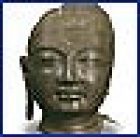September 21, 2005 (Wed) - October 16, 2005 (Sun)
A special feature of the Buddha Head of Kohfukuji, which often appears in textbooks to represent the Hakuho period (late Asuka period) sculptures.

September 21, 2005 (Wed) - October 16, 2005 (Sun)
A special feature of the Buddha Head of Kohfukuji, which often appears in textbooks to represent the Hakuho period (late Asuka period) sculptures.
|
|
|
|
| Period | Wednesday, September 21 - Sunday, October 16, 2005 | ||||
|
|
|||||
| Venue | Room T5, Honkan, Tokyo National Museum (Ueno Park) | ||||
|
|
|||||
| Hours |
9:30 - 17:00 - 20:00 on the following Fridays; October 7, 14, 2005 - 18:00 on Saturdays and Sundays in September (Last entry 30 minutes before closing) |
||||
|
|
|||||
| Closed | Mondays (Except for Monday, October 10, 2005; closed Tuesday, October 11, 2005 instead) | ||||
|
|
|||||
| Admissions |
Adult 420 (210) yen, University Student 130 (70) yen High school, junior high school and elementary school students: Free
|
||||
|
|
|||||
| Access |
10 minutes walk from JR Ueno Station (Park exit) and Uguisudani Station 15 minutes walk from Keisei Ueno Station, Tokyo Metro Ueno Station and Nezu Station |
||||
|
|
|||||
| Organizers | Tokyo National Museum, Kohfukuji, Nihon Keizai Shimbun | ||||
|
|
|||||
| General Inquiries | +81-3-3822-1111 | ||||
|
|
|||||
|
|
||||||||
|
||||||||
|
|
|
|
|
|
Splendid and Refined: Imari Ware and Kyoto Ware Ceramics
Hyokeikan, Tuesday, October 4 - Sunday, December 4, 2005 |
|
|
|
|
|
|
|
|
On October 30, 1937, the head of a Buddhist statue was found from inside the pedestal of the statue of Yakushi Nyorai (Bhaisajyaguru), the principle image at the
East Main Hall of Kohfukuji that was under repair. It was the head of the statue which was the principle image of the hall during the Kamakura period, when Kohfukuji was revitalized.
It was formerly the principle image of the lecture hall of Yamada-dera temple in Asuka. Yamada-dera was founded by Soganokura no Yamada no Ishikawamaro, a figure who took an active part in the Taika Reform in 645. Later he committed suicide, being accused of plotting a rebellion. The statue was made to pray for his soul. Record tells that the casting of the gilt bronze statue began in 678, and the ceremony of its completion was held in 685. The statue was said to have been burnt down together with the East Main Hall in 1400, but the head had miraculously survived. Its noble feature with the eyes that appear to gaze far beyond reminds that of a youth. This statue truly represents Hakuho art, by which the fine arts of Japan reached a new stage with influence from the early Tang art from China. |
|
|
|
|
|
|
||||||
|
||||||